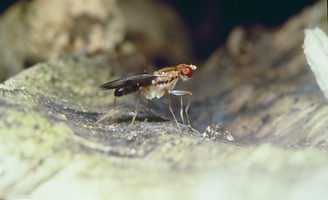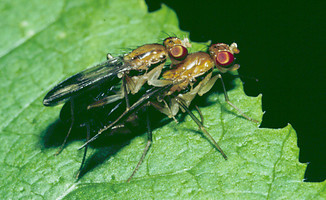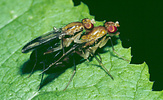Clusia
Owen Lonsdale and Steve MarshallIntroduction
Clusia Haliday and Paraclusia Czerny occur in the Holarctic Regions, and are comprised of six and four species, respectively. Clusia czernyi and C. lateralis are found in northeast North America and C. occidentalis is found along the west coast from British Colombia to California; P. tigrina is known from Europe, C. flava has been recorded in Europe and Japan, and C. sexlineata is found in Burma; the remaining species occur in Japan. Clusia and Paraclusia share highly reduced ocellar bristles, well developed interfrontal bristles, and have been treated as Clusiinae by Frey (1960) and Sasakawa (1977) on the basis of an inclinate pair of anterior fronto-orbital bristles.
Adults are often found on a wide range deciduous tree species (observations on conifers such as pine and spruce are much less frequent), preferring either stumps or dead, bare wood on standing trunks or living trees (Roh?cek 1995, Stubbs 1982, personal obs.). Stubbs (1982) found adults of P. tigrina most often in August and September on barkless spots of live beech trees. European Clusia have been reared from the stumps of several deciduous species (beech, birch, elm; Perry & Stubbs 1978, Smith 1950) and occasionally from conifers (Soos 1981). North American adults have been reared from 'moist wood', 'dead Populus tremuloides' and the 'cambium of dead maple'. Smith (1950) collected puparia of Clusia flava in a dry beech stump (10'X2') one inch from the surface in early April (emerged towards the end of the month).
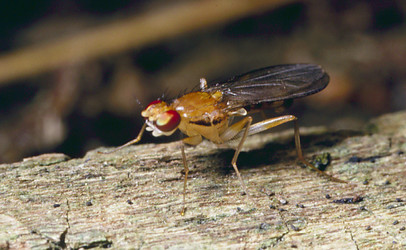 image info
image info
Clusia lateralis (Walker) on dead wood. Northeastern North America. ? Steve Marshall
Characteristics
The synapomorphies we use to define Clusia are as follows: postvertical bristle minute to absent; arista pubescent to short plumose; interfrontal bristle present; scutellum yellow with lateral margin brown (entirely yellow in some species); posterior cross-vein surrounded by wide infuscation (absent in some species); head of aedeagal apodeme not much wider than shaft and only gradually wider distally; hypandrial arm extending past basiphallus; epiphallus strongly sclerotized and produced anteriorly; postgonite small, elongate and confluent with pregonite.
The species of Clusia and Paraclusia outside Japan can often be separated by distribution alone, but the eastern North American C. czernyi (with a median band on the wing and one pair of lateral scutellar bristles) and C. lateralis (with no median band on the wing and two pairs of lateral scutellar bristles) are almost entirely sympatric.
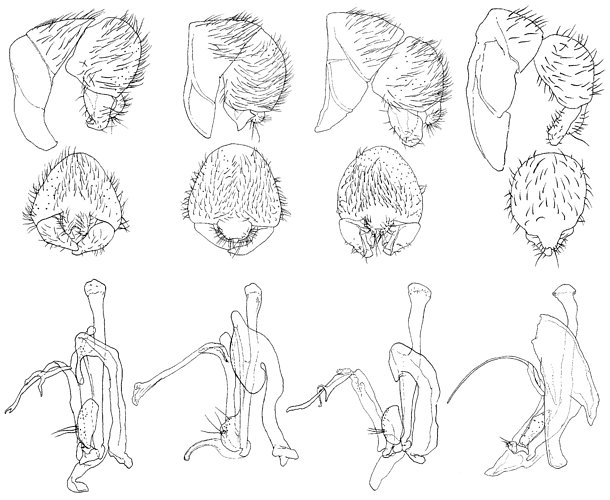 image info
image info
Figure: Male genitalia, external left lateral, external posterior, internal left lateral (left to right): Clusia czernyi Johnson; Clusia lateralis (Walker); Clusia occidentalis Malloch; Clusia flava (Meigen). ? Owen Lonsdale.
Phylogenetics
Clusia and Paraclusia have been placed in the Clusiinae on the basis of an inclinate anterior fronto-orbital bristle, a small ratio of the length of the ultimate section of vein M to the penultimate, outstanding bristles on the posterodorsal surface of the fore femur, an acute process on the inner-basal face of the surstylus, a bent distiphallus, and a posteromedial truncate notch on the vertex (Lonsdale & Marshall in press).
A revision of Clusia and Paraclusia is currently being prepared (Lonsdale & Marshall in manuscript), where Paraclusia is to be included as a junior synonym of Clusia.
References
Frey, R. 1960. Studien ?ber indoaustralische Clusiiden (Dipt.) nebst Katalog der Clusiiden. Commentationes Biologicae 22(2): 1-31.
Lonsdale, O & Marshall, S.A. In press, a. Redefinition of the Clusiinae and Clusiodinae, description of the new subfamily Sobarocephalinae, revision of the genus Chaetoclusia and a description of Procerosoma gen. nov. (Diptera: Clusiidae). European Journal of Entomology.
Sasakawa, M. 1977. Family Clusiidae. In M.D. Delfinado & D.E. Hardy (editors). A catalog of the Diptera of the Oriental region. Pp. 234-239. University Press of Hawaii, Honolulu.
Roh?cek, J. 1995. Clusiidae (Diptera) of the Czech and Slovak Republics: Faunistics and notes on biology and behaviour. Cas. Slez. Muz. Opava (A) 44: 123-140.
Stubbs, A.E. 1982. An identification guide to British Clusiidae. Proceedings of the Transactions of the British Entomological Natural History Society 15: 89-93.
Perry, I. & A.E. Stubbs. 1978. Dead wood and Sap runs. A Dipterist's Handbook 15: 65-73.
Smith, K.G.V. 1950. The puparium of Clusia flava Mg. (Diptera: Clusiidae). The Entomologist's Monthly Magazine 86:53.
Title Illustrations
| Scientific Name | Clusia czernyi Johnson |
|---|---|
| Location | Northeastern North America |
| Specimen Condition | Live Specimen |
| Sex | Male |
| Life Cycle Stage | Adult |
| Copyright | © Owen Lonsdale |
| Scientific Name | Clusia czernyi |
|---|---|
| Location | Northeastern North America |
| Specimen Condition | Live Specimen |
| Behavior | In copulae |
| Life Cycle Stage | Adult |
| Copyright | © Steve Marshall |
About This Page
Owen Lonsdale
Insect Systematics Lab
Department of Environmental Biology
University of Guelph
Guelph, ON
N1G 2W1
Canada
Steve Marshall
Insect Systematics Lab
Department of Environmental Biology
University of Guelph
Guelph, ON
N1G 2W1
Canada
Correspondence regarding this page should be directed to Owen Lonsdale at and Steve Marshall at
Page copyright © 2005 Owen Lonsdale and Steve Marshall
- First online 25 August 2005
Citing this page:
Lonsdale, Owen and Marshall, Steve. 2005. Clusia. Version 25 August 2005 (under construction). http://tolweb.org/Clusia/27675/2005.08.25 in The Tree of Life Web Project, http://tolweb.org/





